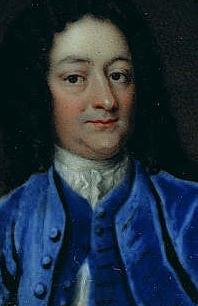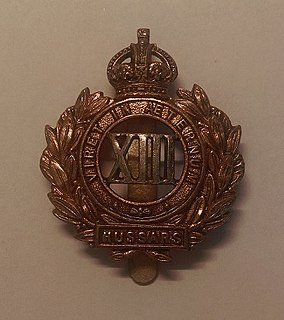This article includes a list of references, related reading or external links, but its sources remain unclear because it lacks inline citations .(February 2013) (Learn how and when to remove this template message) |
The Duke of Kingston's Regiment of Light Horse was a volunteer cavalry regiment raised in Nottinghamshire in 1745 by the Duke at his own expense, in imitation of hussars in foreign service, and disbanded in 1746.

Nottinghamshire is a county in the East Midlands region of England, bordering South Yorkshire to the north-west, Lincolnshire to the east, Leicestershire to the south, and Derbyshire to the west. The traditional county town is Nottingham, though the county council is based in West Bridgford in the borough of Rushcliffe, at a site facing Nottingham over the River Trent.
It was raised by the 2nd Duke of Kingston, ranked as the 10th Horse, and offered for service in the Jacobite rising of 1745, where it fought at Culloden. Since they were newly raised and the troopers weren't regulars they behaved in a less disciplined manner, especially in the pursuit after Culloden when they cut down some innocent civilians including women and children along the Inverness road, while pursuing the retreating Jacobites.

General Evelyn Pierrepont, 2nd Duke of Kingston-upon-Hull, KG was an English nobleman and landowner, a member of the House of Lords. He was the only son of William Pierrepont, Earl of Kingston (1692–1713) and his wife, Rachel Bayntun (1695–1722).

The Jacobite rising of 1745, also known as the Forty-five Rebellion or simply the '45, was an attempt by Charles Edward Stuart to regain the British throne for his father, James Francis Edward Stuart. It took place during the War of the Austrian Succession, when the bulk of the British Army was fighting in mainland Europe, and proved to be the last in a series of revolts that began in 1689, with major outbreaks in 1708, 1715 and 1719.
The men had enlisted for the duration of the fighting, and so the regiment was disbanded at Nottingham in September 1746, with the Duke of Cumberland enlisting most of the men (all but eight of the original) into the newly formed Duke of Cumberland's Regiment of Light Dragoons.

Prince William Augustus, Duke of Cumberland,, was the third and youngest son of King George II of Great Britain and Ireland and his wife, Caroline of Ansbach. He was Duke of Cumberland from 1726. He is best remembered for his role in putting down the Jacobite Rising at the Battle of Culloden in 1746, which made him immensely popular throughout Britain. He is often referred to by the nickname given to him by his Tory opponents: 'Butcher' Cumberland. Despite his triumph at Culloden, he had a largely unsuccessful military career. Between 1748 and 1755 he attempted to enact a series of army reforms that were resisted by the opposition and by the army itself. Following the Convention of Klosterzeven in 1757, he never again held active military command and switched his attentions to politics and horse racing.
The Duke of Cumberland's Regiment of Light Dragoons was a cavalry regiment of the British Army raised in 1746 and disbanded in 1749.














